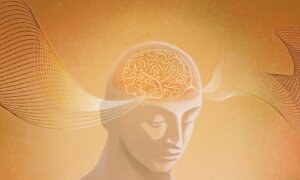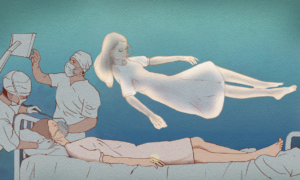Many chronic diseases can be traced to mitochondrial dysfunction, according to Chen Junxu, a natural medicine expert at Bastyr University. After reviewing more than 500 research papers and drawing from his extensive clinical practice, Chen developed a comprehensive theory about the relationship between mitochondrial health and chronic disease, which he shared in a recent interview on NTDTV’s “Health 1+1.”
Understanding Mitochondria’s Vital Role
Mitochondria are often called the power generators of human cells. They convert nutrients such as glucose and fatty acids that we obtain from food into adenosine triphosphate, the primary energy source in our cells.
Mitochondria are the core of human immunity, too. Healthy mitochondria effectively regulate immune responses, while mitochondrial dysfunction can damage immune cells, resulting in many chronic diseases and impaired cellular differentiation.
Chen argues that seemingly diverse conditions—including diabetes, hypertension, heart disease, cancer, allergies, autoimmune diseases such as rheumatoid arthritis, and even various mental illnesses—can be understood through a “unified theory” of mitochondrial imbalance. This means that almost every disease can be traced to mitochondrial imbalance. This perspective suggests that about 90 percent of chronic diseases stem from problems with mitochondrial metabolism.
Chen quoted Dr. Chris Palmer, assistant professor of psychiatry at Harvard University and founder and director of the Metabolic and Mental Health Program at McLean Hospital, as saying that mental illnesses are metabolic syndromes. That means mental illnesses and metabolic diseases such as diabetes, hypertension, heart disease, and cancer are all caused by problems with cell metabolism, which has its functional core residing in the mitochondria.
His theory about mitochondria is fully illustrated in his recent publication “Renewal of Mitochondria to Cure Chronic Diseases.” He said this book is written from a relatively “avant-garde” perspective of medical investigation, exploring why people get sick and whether the human body possesses an infallible health mechanism. He predicts that the study of mitochondria will become a handy tool in empirical medicine in the next three decades.
The ‘Cocktail Therapy’ That Repairs Mitochondria
Chen has developed a comprehensive “cocktail therapy” approach to restore and enhance mitochondrial function. This protocol includes five key components.
1. Optimizing Energy Sources
Start with a low-carb ketogenic diet, with no more than 30 grams (1 ounce) of carbohydrates per day. Switching the fuel supply to mitochondria from glucose to ketones can lower blood sugar and keep it stable. This can also allow the mitochondria function to return to normal gradually, allowing the pancreas, liver, and immune system to return to a healthy state. This is a remedy for the mitochondria that were damaged by a long-term
high sugar (carbohydrate) diet,
staying up late, and other factors.
If the mitochondria of the pancreas and liver are damaged because of these factors, insulin resistance or reduced glucose tolerance will occur and may even lead to diabetes, Chen said. Once the fuel source switches from glucose to ketones, the body breaks free from the limitations of glucose metabolism. Mitochondria, now unburdened, can efficiently use ketones for energy. This revitalizes organs such as the pancreas and liver, restoring their proper functions.
2. Nutrient Supplementation
The next step is to use certain nutrients to repair and renew the mitochondria. This includes supplementing the mitochondria with the primary important antioxidant, glutathione.
Since this nutrient cannot be taken directly because it will be destroyed by gastric acid, we can take some of its precursors, including N-acetyl cysteine and glycine, as supplements. They will synthesize an appropriate amount of glutathione, which will neutralize the free radicals produced by the mitochondria and help them repair themselves, allowing the mitochondria to become healthy again.
3. Grounding and Environmental Factors
Another approach involves restoring
mitochondrial membrane potential through grounding, either by direct earth contact or exposure to the Schumann resonances. This natural electromagnetic frequency from Earth can help normalize cell membrane potential, preserving up to 20 percent of mitochondrial production capacity.
Mitochondria usually expend about 20 percent of their energy each night restoring normal cell membrane potential. External grounding and pulsed electromagnetic field therapy, a noninvasive treatment that uses electromagnetic fields to promote healing and improve various health conditions, can reduce this energy burden on the mitochondria.
This approach, Chen suggests, could not only reverse disease but also help achieve optimal health and vitality.
4. Quality Sleep
Chen emphasized that “mitochondrial cocktail therapy” also needs to go with exercise and good rest. Equally important is to avoid damage to mitochondria from environmental pollution, food additives, pesticides, and other toxins.
He specifically mentioned that one must maintain a quality sleep routine and ensure an adequate amount of deep sleep every night. Although this may sound like common sense, most people don’t do it.
5. ‘Zone 2’ Exercise
Chen strongly recommends “
Zone 2” exercise, which focuses on low-heart rate training. This type of exercise uses aerobic respiration but does not produce lactic acid, so it won’t make you feel tired.
Zone 2 exercises include ultra-slow jogging, brisk walking, and leisurely biking. You should be able to talk during these activities, but you'll notice that you’re breathing a bit harder. This level of exercise helps improve mitochondrial efficiency, gradually repairing organs.
In contrast, more intense endurance training can increase the number of mitochondria, boosting their overall production capacity.
According to Chen, any form of exercise benefits mitochondrial health, whether it improves efficiency, increases the number of mitochondria, or both. However, Zone 2 exercise is more manageable for most people. It’s less likely to cause injuries and can be done indoors or outdoors, making it a more accessible option.
Why Do People Get Sick?
Chen emphasized that illness often results from violations of natural health principles, whether through environmental factors or personal choices. He suggested that disease can serve as a warning signal, prompting necessary lifestyle adjustments.
Key preventive measures include:
- Avoiding environmental toxins
- Limiting exposure to food additives and pesticides
- Making conscious dietary choices
- Maintaining consistent sleep patterns
- Getting regular exercise appropriate to individual fitness levels
Chen said that sometimes illness can be a blessing in disguise that reminds people of the need to rest, adjust their lifestyle, retreat from their earlier mistakes, and return their bodies to a healthy state.

















